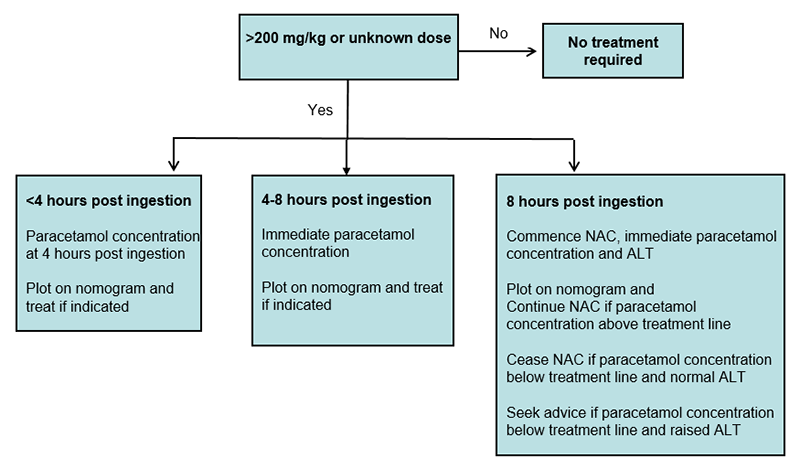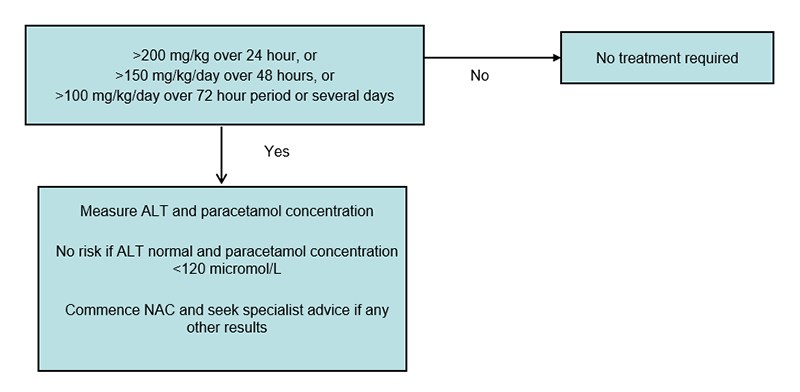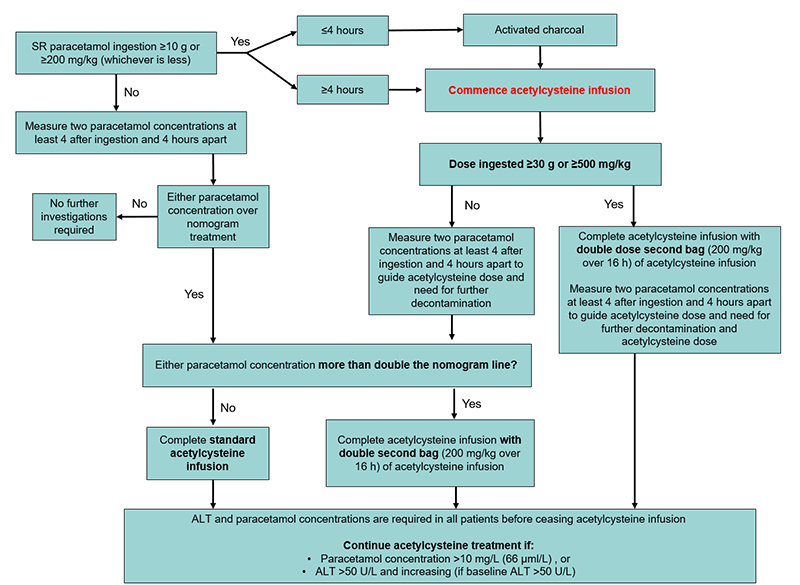See also:
Poisoning – acute guidelines for initial management
Resuscitation
Key points
- Suspect paracetamol poisoning in all deliberate adolescent self-poisonings
- N-acetylcystine (NAC) is a safe and effective antidote. Time to NAC is crucial in protecting the liver from significant toxicity
- Stated timing and dose of paracetamol ingestion are often unreliable and this needs to be taken into consideration
- Complicated overdoses involving longer-acting forms of paracetamol (eg Panadol Osteo) or staggered ingestions should be discussed with a toxicologist
For 24 hour advice, contact the Poisons Information Centre 13 11 26
Background
- Paracetamol is the most widely used over-the-counter analgesic in the world
- It is involved in a large proportion of accidental paediatric exposures and deliberate self-poisonings and is the leading pharmaceutical agent prompting calls to poisons information centres across Australia and New Zealand
- Hepatic failure and death are uncommon outcomes, but paracetamol remains the most important single cause of acute fulminant hepatic failure in Western countries
Children requiring assessment
- Acute ingestion of >200 mg/kg
- Ingestion of unknown quantity
- Repeated supratherapeutic ingestion of >100 mg/kg/day
- All children with deliberate self-poisoning
- Any symptomatic child
- Any child whose developmental age is inconsistent with accidental poisoning as non-accidental poisoning should be considered
Risk assessment
History
Intentional overdose or accidental
Dose:
Stated or likely dose taken
Form: syrup, immediate or modified-release tablets
If possible, determine the exact name and tablet size
Calculate the maximum possible dose per kg
Consider the possibility of co-ingestions, either accidental or deliberate
Examination
- Most patients who present within 24 hours of ingestion are asymptomatic.
- Occasionally they complain of nausea, vomiting, pallor and diaphoresis
- Right upper quadrant tenderness may begin to develop subsequently
- In untreated or undertreated cases, signs of hepatotoxicity and hepatic failure usually take 48–72 hours to develop and may include hypotension and encephalopathy
- Signs of fulminant hepatic failure and coagulopathy can occur later than this
Investigations
- Serum paracetamol concentration at (or as soon as possible after) 4 hours post ingestion determines the need for N-acetyl cysteine (NAC) administration (see
Nomogram below)
- There is no benefit in measuring paracetamol concentration earlier than 4 hours post ingestion
Acute Management
- It is safe to wait for the paracetamol concentration to decide on the need for NAC in all cases that present within 8 hours of ingestion AND where a paracetamol concentration result will be available for interpretation within 8 hours of ingestion
- Patients who present >8 hours after a toxic ingestion (>200 mg/kg) or after an ingestion associated with symptoms of toxicity (RUQ pain or tenderness, nausea, vomiting) should be commenced on NAC immediately. The decision to continue or cease NAC is then based on the paracetamol concentration
- Delaying NAC administration beyond 8 hours post ingestion is associated with a progressive increased risk of liver injury
- There is little evidence to guide management in repeated supratherapeutic doses. Potential toxicity should be assessed and a toxicologist consulted when:
- >200 mg/kg (or 10 g) ingested over a 24 hour period
- >150 mg/kg/day (or 6 g) ingested over a 48 hour period
- >100 mg/kg/day ingested over a 72 hour period
- Consult a toxicologist in cases of very large dose ingestion (>30 g) or if initial paracetamol concentration very high (ie ≥double the nomogram value)
- For IV paracetamol medication errors consult a toxicologist
- See management algorithms and
NAC infusion instructions below
Single acute paracetamol ingestion

Nomogram for acute single dose paracetamol poisoning

Multiple supratherapeutic paracetamol ingestion

Sustained Release Paracetamol
- NAC should be commenced in any patient who reports ingestion of >200 mg/kg or 10 g of sustained release paracetamol
- An initial paracetamol concentration should be measured 4 hours post ingestion or immediately if presentation is >4 hours after ingestion. If this concentration is above the treatment line in the nomogram then the full 20 hour infusion of NAC is required
- If the initial paracetamol concentration is below the line in the nomogram then NAC should be continued, and another paracetamol concentration obtained 4 hours after the initial concentration. NAC can be discontinued if both paracetamol concentrations are below the treatment line and are declining
Sustained release paracetamol ingestion

N-Acetyl cysteine (NAC) infusion instructions
The standard administration of NAC is a 2 stage infusion (recently changed from 3 stage infusion) giving a total dose of 300 mg/kg:
- 200 mg/kg over 4 hours
- 100 mg/kg over the next 16 hours
Dose calculated based on actual body weight. For patients >110 kg, calculate the dose based on 110 kg body weight.
NAC may be diluted in 5% glucose or 0.9% sodium chloride (normal saline). It can also be diluted in combination glucose-sodium chloride solutions not exceeding these concentrations including 0.45% sodium chloride in 5% glucose, and 0.9% sodium chloride in 5% glucose.
The volume and choice of fluid for each stage of the infusion needs to be appropriate for the age and weight of the child and clinical circumstances. In the adolescent patient, it is generally appropriate to follow the standard published recommendations for NAC administration.
The volume of NAC needs to be included in the TOTAL volume of the infusion to avoid under-dosing (volumes specified in tables below are TOTAL volumes – ie NAC volume plus fluid volume combined).
Children or adolescents >40 kg (recommended ceiling weight 110 kg):
| Infusion stage
|
NAC dose
|
Dilute to
(using glucose 5%)
|
Infusion duration
|
|
First
|
200 mg/kg
|
TOTAL volume 500 mL
|
4 hours
|
|
Second
|
100 mg/kg
|
TOTAL volume 1000 mL
|
16 hours
|
For children 20 – 40 kg body weight:
| Infusion stage
|
NAC dose
|
Dilute to
(using sodium chloride or glucose)
|
Rate and duration
|
|
First
|
200 mg/kg
|
TOTAL volume 250 mL
|
62.5 mL/hr for 4 hours
Infuse entire bag
|
|
Second
|
100 mg/kg
|
TOTAL volume 500 mL
|
31.25 mL /hr for 16 hours
Infuse the entire bag
|
NOTE: this results in a total of 750 mL of fluid which is inappropriate for smaller children.
For children ≤20 kg body weight:
| Infusion stage
|
NAC dose
|
Dilute to
(using sodium chloride or glucose)
|
Rate and duration
|
|
First
|
200 mg/kg
|
TOTAL volume 250 mL**
|
62.5 mL/hr** for 4 hours
Infuse entire bag
|
|
Second
|
100 mg/kg
|
TOTAL volume 250 mL**
|
15 mL/hr** for 16 hours
Infuse entire bag
|
**For infants, even smaller volumes may be required. Doses can be diluted in 100 mL bags if available (note: the entire dose must be administered over the specified time.). For infants who are fluid restricted with concerns about fluid overload and a smaller total volume is required, contact hospital pharmacist for advice.
Infant example
Infusion stage
|
NAC Dose
|
Dilute to
(using sodium chloride or glucose)
|
Rate and Duration
|
|
First
|
200 mg/kg
|
TOTAL volume 100 mL
|
25 mL/hr for 4 hours
Infuse entire bag
|
|
Second
|
100 mg/kg
|
TOTAL volume 250 mL
|
15.7 mL/hr for 16 hours
Infuse entire bag
|
Additional fluids
In all cases, additional maintenance fluids can be given if required, or NAC may be administered in larger volume bags if more convenient.
Monitoring
At 18 hours into the NAC infusion (2 hours before completion), send bloods for:
- Paracetamol level
- ALT
- Urea, electrolytes, creatinine (5% of patients with paracetamol toxicity will develop acute renal injury)
The NAC infusion should be discontinued only once the:
- AST, ALT and INR have reached their peak levels and are declining
- urea, electrolytes and creatinine have normalised
and - paracetamol level has returned to normal (ie below 66 micromol/L)
Dosing Errors
NAC dosing or administration errors should be discussed with a toxicologist.
Consider consultation with local paediatric team when
Admission should be considered for all children and young people with an intentional overdose.
Consult Victorian Poisons Information Centre 13 11 26 for advice
Consider transfer when
Children requiring care beyond the comfort level of the hospital
For emergency advice and paediatric or neonatal ICU transfers, see
Retrieval Services.
Consider discharge when
- No further NAC requirement and investigations are within normal limits (see
Monitoring)
- For deliberate ingestions, a risk assessment should indicate that the patient is at low risk of further self-harm in the discharge setting
Assessing risk and connecting to community services
- Prior to discharge, adolescents who present with deliberate ingestions need a risk assessment regarding the likelihood of further ingestions or other attempts to self-harm
- Assessment of other drug and alcohol use should also be undertaken
- If, after risk assessment, it is deemed safe to discharge a patient from hospital, but ongoing mental health or drug and alcohol needs are identified, the adolescent should be linked with appropriate services (see links below for services in the State of Victoria).
Discharge information and follow-up:
Parent Information:
Poisoning prevention for children
Prevention of poisoning (Victorian Poisons Information Centre)
Poisons Information Centre: phone 13 11 26
Victoria
Poisons Information Centre
Child & Adolescent Mental Health Services (CAMHS): Victorian government mental health services are region-based
Orygen Youth Health: Specialist mental health services for people aged 15 – 25 years, residing in the western and north-western regions of metropolitan Melbourne. Triage/intake - 1800 888 320.
Headspace: National Youth Mental Health Foundation with
local headspace centres
YSAS (Youth Support and Advocacy Service): Outreach teams across Melbourne and regional Victoria for young people experiencing significant problems with alcohol and/or drug use
YoDAA: Victoria’s Youth Drug and Alcohol Advice service - provides information and support for youth AOD needs or anyone concerned about a young person
Infoxchange Service Seeker: Search for local community support services eg local doctor, dentist, counselling services, drug and alcohol services.
Additional notes
Anaphylactoid reactions to NAC may occur (wheeze, rash). In these cases, cease the infusion for 30 minutes, give promethazine then recommence the infusion at half the previous rate. Slowly increase to the full rate over 30 minutes.
Last updated February 2021